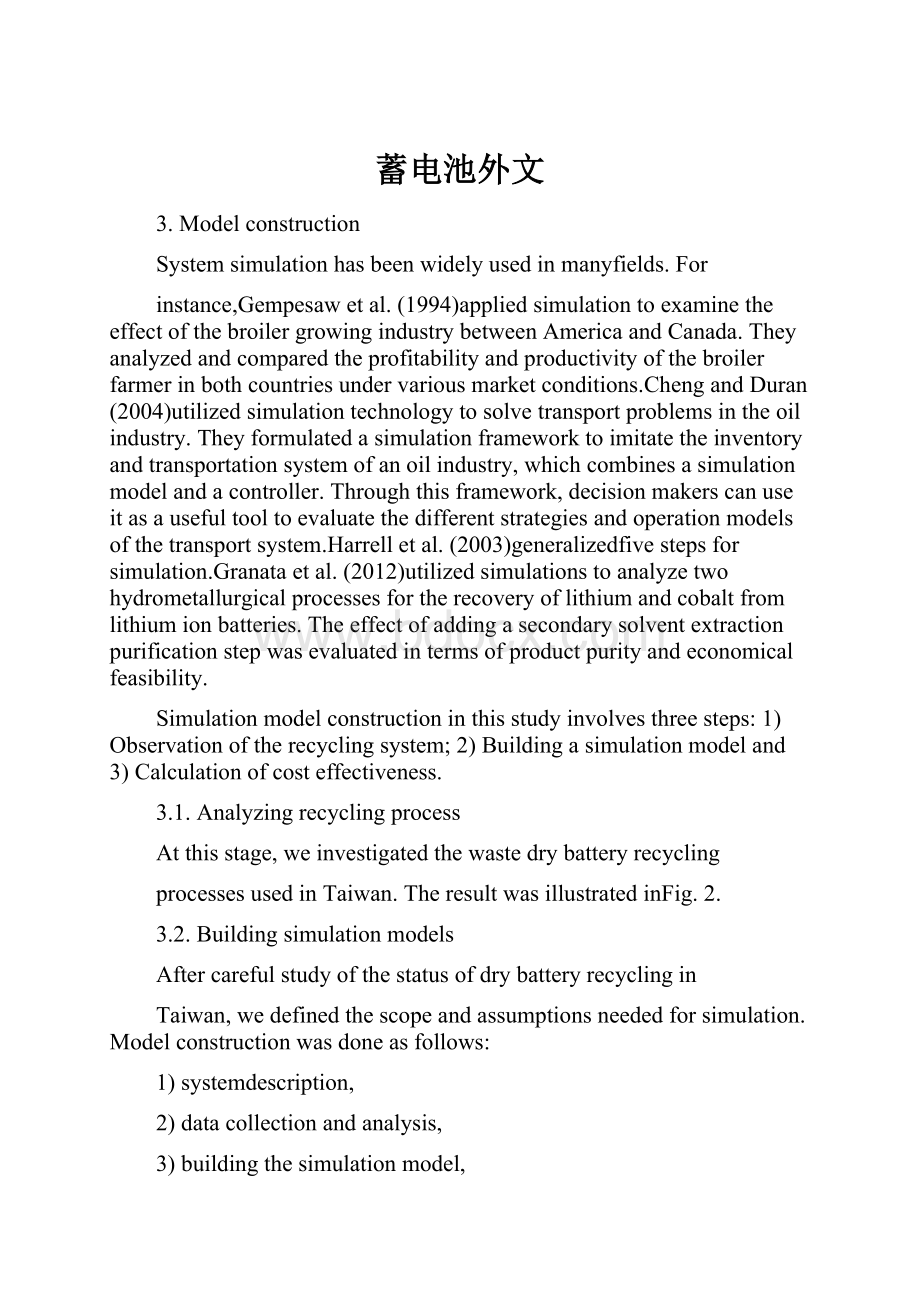蓄电池外文.docx
《蓄电池外文.docx》由会员分享,可在线阅读,更多相关《蓄电池外文.docx(16页珍藏版)》请在冰豆网上搜索。

蓄电池外文
3.Modelconstruction
Systemsimulationhasbeenwidelyusedinmanyfields.For
instance,Gempesawetal.(1994)appliedsimulationtoexaminetheeffectofthebroilergrowingindustrybetweenAmericaandCanada.Theyanalyzedandcomparedtheprofitabilityandproductivityofthebroilerfarmerinbothcountriesundervariousmarketconditions.ChengandDuran(2004)utilizedsimulationtechnologytosolvetransportproblemsintheoilindustry.Theyformulatedasimulationframeworktoimitatetheinventoryandtransportationsystemofanoilindustry,whichcombinesasimulationmodelandacontroller.Throughthisframework,decisionmakerscanuseitasausefultooltoevaluatethedifferentstrategiesandoperationmodelsofthetransportsystem.Harrelletal.(2003)generalizedfivestepsforsimulation.Granataetal.(2012)utilizedsimulationstoanalyzetwohydrometallurgicalprocessesfortherecoveryoflithiumandcobaltfromlithiumionbatteries.Theeffectofaddingasecondarysolventextractionpurificationstepwasevaluatedintermsofproductpurityandeconomicalfeasibility.
Simulationmodelconstructioninthisstudyinvolvesthreesteps:
1)Observationoftherecyclingsystem;2)Buildingasimulationmodeland3)Calculationofcosteffectiveness.
3.1.Analyzingrecyclingprocess
Atthisstage,weinvestigatedthewastedrybatteryrecycling
processesusedinTaiwan.TheresultwasillustratedinFig.2.
3.2.Buildingsimulationmodels
Aftercarefulstudyofthestatusofdrybatteryrecyclingin
Taiwan,wedefinedthescopeandassumptionsneededforsimulation.Modelconstructionwasdoneasfollows:
1)systemdescription,
2)datacollectionandanalysis,
3)buildingthesimulationmodel,
4)modelverificationandvalidation.
3.2.1.Systemdescription
Acomprehensivedescriptionofthesystemwaspreparedbefore
themodelwasbuilt.Usingtheexistingwastedrybatteryrecycling
arrangementsinTaiwanasabasis,webuiltuprecyclingsystemsfor
thethreeschemeswewantedtopinpoint.Twoimportantaspects
oftheproblem,thepurchasebehaviorofdifferentconsumergroups
andcosteffectivenesswereconsideredindetail.
3.2.2.Datacollectionandanalysis
Torunthesesimulationmodelsitisnecessarytoconfigurethe
parameterstomimicarealworldsystem.Thedatausedwas
collectedfromtheliteratureandfrominterviewswithexperts.
Reasonableassumptionsweremadefordatathatwasunavailable
fromthesesources.
Theparametersandschemeconceptforthisresearchwere
basedondatafromaseriesofprojectscarriedoutfortheEnvironmentProtectionAssociation(EPA)ofTaiwanbyexpertsinthe
relatedfields.Usingpracticaldatacanreducethedeviationduring
simulationandanalysis.
Table1showstheparametersandtheirsourcetypes.
3.2.3.Buildingthesimulationmodels
WeusedthesimulationsoftwarepackageeM-Planttobuildthe
threemodelsthatwillbediscussedhere:
1)theexistingrecycling
schemeasusedinTaiwan,2)adepositsystem,and3)anorganized
producerresponsibilityscheme(PRO)combinedwithadeposit
system.Figs.3e5illustratethesemodels.
Inthefirstsimulationexperiment,componentsofthesystem
aretheproducer,market,consumer,recycleranddomesticprocesser.Producersdistributenewbatteriesonthemarket.Consumerssendtheirusedbatteriestorecyclingcollectionpoints.Recyclerscollecttheusedbatteriesandresellthemtodomesticcompaniesforprocessing.
Inthesecondsimulationmodel,thatincludesthedepositsystem,thecomponentsarethesamebuttheconsumersareseparatedintotwogroups:
thosewhoreturnedausedbatterywhenbuyinganewoneandthosewhodonot.Theusedbatteriesarestillcollectedbyrecyclerstoberesoldtodomesticprocessers.
Therearemorecomplexvariationsinthelastsimulationexperiment.Consumersareseparatedintothreegroups:
thosewhoreturnausedbattery,buywithoutareturn,andthosewhobuyaplatformbattery.TherearetwotypesofRecyclers:
self-recyclersandplatform-recyclers.Batteriesthatbelongtothedepositsystemgroupwillbecollectedbyself-recyclers.Batteriesinthebuyplatformwillbecollectedbyplatform-recyclers.Thesebatterieswillalsoberesoldtodomesticprocessers.
3.2.4.Modelverificationandvalidation
Carefulverificationofthemodelisimportanttoensurethese
modelsbehaveasexpected,andtoconfirmthatbehaviorofthesystemcomplieswiththeassumptions.Forthispurposewedesignedavisualmethodusinganimationwhichallowedveryclearobservationofsystembehaviorandmadeiteasytoseeerrorsandmakecorrectionstoimprovethemodel.
Validationisfocusedoncorrectoutputdata,butbecausethe
modelsusedherearealmostnon-existentinpractice,weusedensitivityanalysistoconfirmvalidityofthedata.
Table1
Parameterandsourcetype.
ParameterSourcetype
BatteryproducetimeReference
BatterydischargetimeReference
RecyclersupplyperiodAssumption
ProcessermachineworktimeReferenceandassumption
3.3.Costeffectivenessdefinition
Inthisresearch,costeffectivenessisexpressedbytheE/Pratio,
wherethetotalcostofthesystemisthedenominatorandthetotal
profitofthesystemthenumerator.TheE/Pratiocanbeinterpreted
astheperformancebenefitofarunningsystemandthiscanbeused
topersuadetheproducerstore-designproductssotheirend-of-life
willhavetheleasteffectontheenvironment.ThelargertheE/P
ratiothebetter.Inaddition,theE/Pratioshouldnotchange
dramaticallyduringsimulationrunstoensuretherationalityand
stabilityofthesimulationmodels.
4.Executingsimulation
TherecyclingsystemforwastedrybatteriesinTaiwanisdifferentfromthatinothercountries.TheRecyclingFundManagementBoardhasbeenestablishedformanyyearsandhasbeenhowntobequiteeffective,buttherearestillmanyoperationalproblems.
Wetookthewastedrybatteryrecyclingsystem,asitexistsin
Taiwan,astheanalysisobject.Webuiltupthreerecyclingsystem
models,accordingtodifferentschemes.Bychangingtherecyclingratesandconsumerproportions,andanalyzingthecosteffectivenessforeachmodel,wewereabletomakeareliableevaluationofthefeasibilityofeachdifferentscheme.
4.1.Schemeexplanationandassumptions
Batteriesarereplacedfrequentlywhentheusagetimeisshort.
Tocontrolthebehaviorofmembersinthesystemaccuratelywould
beverydifficultandtheamountofdatawouldbehuge.Therefore,
wefocusonhowthedifferentrecyclingrates,consumerproportionsanddifferentrecyclingsystemsaffectthecosteffectiveness.Weshowthesemembersasanodeandobservehowbatteriesshiftinthesystemandthenumberofbatteriesthatstayintheconsumergroups.
Beforestartingthesimulationexperiments,weneededtomakesomeassumptions:
1.Thedrybatteriesconsideredherearezincandnon-buttontype
alkalinemanganeseunits.AlthoughtheprocessersinTaiwan
haveestablishedarecoveryprocessforsecond-gradebatteries,
itstilldoesnotwork,andonlyfirst-gradebatteryrecoveryis
consideredhere.
2.Itwasassumedtheinventoryandrecoveryvolumecouldsatisfy
systeminput.
3.Executiontimewaseighthoursperday,fivedaysaweek,for51
weeksperyearoveraperiodofthreeyears.
4.Themeanandstandarddeviationwassetaccordingtothesales
volumesinTaiwanbetween2002and2008.
5.Thesimulationtime,usingtheoriginalsalesvolumes,would
havebeenfartoolongandwethereforescaleditdownbya
factorof300.
6.Consumerbehaviorisassumedtobethesameforallthe
differentschemes.
7.Thecommonparametersaresetthesameforeachscheme.
8.Thesystemscopestartswiththeproducersandendswiththe
domesticprocessers.
4.1.1.Scheme1:
theexistingrecyclingsystem
Inthisscheme,producersandimportersreleasenewbatteriestomarket.Consumerswillretain25%ofthebatteriesasinventorywhentheybuynewbatteries.Theusedbatterieswillbesenttorecyclingstationsandcollectedbytherecyclers,whoreselltodomesticprocessersforrecycling.Afterclassifying,crushing,sievingandmagneticseparation,wastedrybatterieswillbetransformedintomanydifferentkindsofresource,suchasiron,zincandmanganesedioxide.
ProducersandimporterspayADFtotheRecyclingFundManagementBoard,accordingtosalesvolume,atthefixedrateofNT$23.50perkilogram.TheRecyclingFundManagementBoardthenpaysasubsidyofNT$43.50perkilogramtotheprocessers.RecyclerssellcollectedwastedrybatteriestodomesticprocessersforNT$28.00perkilogram.Aftertherecyclingprocess,processersselltherecoveredresourcesatNT$9.25perkilogramforiron;NT$14.50perkilogramforsieving;andNT$3.00perkilogramfor
Table2
Simulationsequencesforscheme1.
SequenceRecyclerate
115%
225%
345%
460%
magneticseparation.DrybatteriesareimportedforNT$104.14perkilogramand43%ofthetotaloutlayisincome.Theyarethensold
onthemarketforNT$24.25perbattery,and30%ofthisisincome.Finally,theRecyclingFundManagementBoardwillexpendNT$2,473,498peryearasauditedcost.ThecashflowdiagramofScheme1isshowninFig.6.
Recyclerscollectwastedrybatteriesfivedaysaweek,andresell
themtodomesticprocessers.Recyclerstake68%ofrevenueasoutlayand32%isincome.Inthismodel,weconsiderfourlevelsofrecyclingrateinfoursimulationexperiments.
4.1.2.Scheme2:
thedepositsystem
HerebasicconditionsarealmostidenticaltothoseinScheme1.
Theonlydifferenceisconsumerseparation.Underthedepositsystemconsumersareseparatedintotwogroups:
Thosewhobuywithbatteriesandthosewhobuywithoutbatteries.
Consumerswhodon